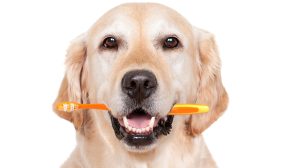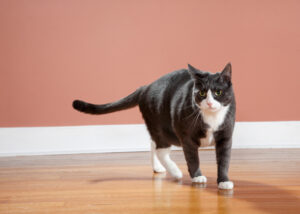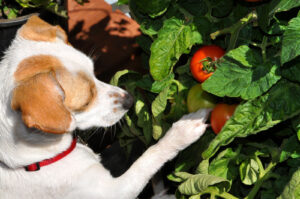Posts Tagged ‘veterinarian’
Unveiling the Smile: Celebrating Pet Dental Health
 While we often focus on keeping our pets healthy through diet and exercise, dental health tends to be overlooked. However, just like us, our pets need proper dental care to maintain overall well-being. Let’s delve into the importance of dental hygiene for our furry friends and discover how we can ensure they flash those pearly whites for years to come.
While we often focus on keeping our pets healthy through diet and exercise, dental health tends to be overlooked. However, just like us, our pets need proper dental care to maintain overall well-being. Let’s delve into the importance of dental hygiene for our furry friends and discover how we can ensure they flash those pearly whites for years to come.
Why Pet Dental Health Matters
Oral health is a vital aspect of your pet’s overall health and can affect their quality of life in significant ways. Dental issues in pets can lead to pain, discomfort, difficulty eating, and even more severe health problems if left untreated. From plaque and tartar buildup to gum disease and tooth decay, the consequences of neglecting dental care can be serious. Additionally, bacteria from dental problems can enter the bloodstream and potentially affect other organs, such as the heart, liver, and kidneys, making regular dental care crucial for your pet’s longevity.
At-Home Dental Hygiene Tips:
Fortunately, there are several simple yet effective ways to promote good dental hygiene for your furry friends right at home:
- Brushing: Just like humans, pets benefit from regular brushing. Use a pet-specific toothbrush and toothpaste to gently clean their teeth. Start slowly and gradually increase the duration of brushing sessions as your pet becomes accustomed to the routine.
- Dental Chews and Toys: Provide your pet with dental chews and toys designed to promote oral health. These products help reduce plaque and tartar buildup by encouraging chewing and saliva production.
- Healthy Diet: Feed your pet a balanced diet consisting of high-quality food and treats. Avoid giving them sugary or sticky treats, as these can contribute to dental problems.
- Regular Inspections: Take the time to regularly inspect your pet’s mouth for signs of dental issues such as bad breath, swollen gums, or discolored teeth. Early detection can prevent the progression of dental disease.
The Role of Professional Dental Cleanings
While at-home care is essential, professional dental cleanings are also necessary to maintain optimal oral health for your pet. Veterinary professionals have the expertise and specialized equipment to perform thorough cleanings and address any underlying dental issues. During a dental cleaning, your pet will undergo scaling to remove plaque and tartar, polishing to smooth the tooth surfaces, and in some cases, extractions or other necessary treatments. Your veterinarian may also recommend dental X-rays to assess the health of your pet’s teeth and gums below the surface.
Let’s pledge to prioritize our furry companions’ oral health and well-being. By incorporating at-home dental hygiene practices and scheduling regular professional cleanings, we can help our pets maintain healthy smiles and lead happier, healthier lives. Remember, a little care goes a long way in ensuring that your pet’s teeth shine as bright as their personalities! Here at Olsen Veterinary Clinic, we are happy to get you on a regular schedule to ensure your pet’s dental health is strong. Contact our office today!
The Importance of Regular Veterinary Check-ups
 Regular veterinary check-ups are crucial for maintaining the overall health and well-being of your pets. These routine visits play a key role in preventative care and early detection of health issues. Here are some reasons why regular veterinary check-ups are important.
Regular veterinary check-ups are crucial for maintaining the overall health and well-being of your pets. These routine visits play a key role in preventative care and early detection of health issues. Here are some reasons why regular veterinary check-ups are important.
Preventative Care:
Regular check-ups allow veterinarians to administer vaccinations, parasite control, and dental care. Preventative measure can help protect your pet from various illnesses, ensuring they lead a healthier longer life.
Early Detection of Health Issues:
Pets, like humans, can develop health issues that may not be immediately apparent. Regular check-ups enable veterinarians to detect potential health problems early, often before symptoms become severe. Early detection can significantly improve the prognosis and treatment outcomes.
Disease Screening:
Veterinary check-ups may include screenings and tests for common pet diseases. These screenings can help identify conditions such as diabetes, kidney disease, and certain types of cancer in their early stages, allowing for timely intervention.
Dental Health:
Dental issues are common in pets, and they can lead to various health problems if left untreated. Regular veterinary visits often include dental examinations and cleanings, promoting good oral health and preventing dental diseases.
Nutritional Guidance:
Veterinarians can provide guidance on proper nutrition based on your pet’s age, breed, and health condition. A well-balanced diet is essential for maintaining your pet’s overall health and preventing nutrition-related issues.
Behavioral Assessment:
Veterinarians can assess your pet’s behavior during routine visits. Changes in behavior may be indicative of underlying health issues and addressing them early can prevent further complications.
Weight Management:
Maintaining a healthy weight is crucial for your pet’s well-being. Regular check-ups allow veterinarians to monitor your pet’s weight and provide guidance on nutrition and exercise to prevent obesity-related health issues.
Senior Pet Care:
As pets age, their healthcare needs may change. Regular check-ups become even more critical for senior pets to monitor and address age-related conditions, such as arthritis, dental problems, and organ dysfunction.
Client Education:
Veterinary visits are an opportunity for pet owners to learn about their pet’s specific needs, behaviors, and potential health risks. Education from veterinarians empowers pet owners to provide the best care possible.
In summary, regular veterinary check-ups are essential for preventative care, early detection of health issues, and ensuring that your pets lead healthy and happy lives. Establishing a consistent schedule of veterinary visits can contribute significantly to the overall well-being of your beloved companions. Contact our office today to schedule yours or if you have any questions.
5 Ways to Keep Your Dog Safe in the Snow
 Keeping a dog safe in the snow is important, as cold weather can pose various risks to their health and well-being. Here are five ways to ensure your dog stays safe in snowy conditions.
Keeping a dog safe in the snow is important, as cold weather can pose various risks to their health and well-being. Here are five ways to ensure your dog stays safe in snowy conditions.
-
- Ensure Adequate Shelter: Ensure that your dog has access to a warm and dry shelter, such as a well-insulated doghouse or a heated indoor space. Limit the time your dog spends outdoors in extreme cold weather, especially during snowstorms.
- Use Protective Gear: Invest in appropriate winter gear for your dog, such as a waterproof and insulated coat. Booties can protect their paws from ice, snow, and harmful chemicals like de-icing salts. Make sure the gear fits properly and doesn’t cause any discomfort.
- Monitor Paw Health: Snow and ice can accumulate between the paw pads, leading to discomfort or injuries. Regularly check your dog’s paws for ice balls, cuts, or signs of frostbite. Wipe their paws with a damp cloth to remove any salt or chemicals.
- Keep Them Hydrated: Cold weather can be dehydrating and dogs may be less inclined to drink water when it is cold. Ensure that your dog has access to fresh water at all times. Dehydration can contribute to health issues, including susceptibility to hypothermia.
- Adjust Diet and Monitor Weight: Dogs my burn more calories in cold weather to stay warm. Adjust their diet accordingly and monitor their weight. A well-nourished dog is better equipped to handle the challenges of cold weather.
Remember that individual dogs have different tolerance levels for cold weather, and factors such as breed, age, and health should be taken into consideration. Always obeserve you dog for signs of discomfort or stress, and consult with your veterinarian if you have specific concerns about your dog’s well-being in snowy conditions.
If at any time you have concerns or questions, do not hesitate to contact our office. Have a safe and fun winter with your pup!
What Is Your Cat Trying to Say? How to Decipher Your Cat’s Body Language
 Have you ever talked to animals? Have you ever wanted to converse with your pets’ and interpret their body language ala Dr. Dolittle? Our pets tend to be very important parts of our lives so interpreting their body language can be important to us.
Have you ever talked to animals? Have you ever wanted to converse with your pets’ and interpret their body language ala Dr. Dolittle? Our pets tend to be very important parts of our lives so interpreting their body language can be important to us.
Tail Position: A cat’s tail position can convey various emotions. A relaxed, straight tail usually means your cat is content. A slightly curved tail might indicate curiosity. A puffed-up tail can indicate fear or agitation, while a flicking tail could mean excitement or annoyance.
Ears: Pay attention to your cat’s ears. Forward-facing ears generally indicate curiosity or interest, whe flattened ears suggest fear, anger, or irritation.
Purring: Purring is often a sign of contentment and happiness, though cats can also purr when they’re anxious or in pain.
Body Posture: A relaxed and stretched-out posture signifies comfort and relaxation. An arched back could indicate fear or aggression, while a crouched stance may mean your cat is ready to play or is feeling defensive.
Eye contact: Direct eye contact can be seen as a challenge or a sign of aggression in the cat world. Slow blinking from your cat is ofter a sign of affection and trust.
Kneading: Cats may knead with their paws, pressing them against you or soft surfaces. This behavior is oftern associated with contentment and comfort, as it is reminiscent of their kittenhood when they kneaded their mother’s belly to stimulate milk flow.
Grooming: Grooming is a common self-soothing behavior in cats. If your cat is grooming itself after a stressful event, it could be a sign that it’s trying to calm down.
Remember that individual cats may have different personalities and quirks, so it is essential to observe your cat’s behavior over time to better understand its unique body language. Additionally, context plays a significant role in interpreting cat body language. Consider the situation and overall environment to make a more accurate interpretation of your cat’s emotions and intentions.
If you have any questions about your pet’s quirks or body language please call us at 618-656-5868 or contact us here. We are here to help.
Tips to Keep Your Pets Safe this Independence Day
 A lot of people will be celebrating Independence Day on July 4th. It is important to think about our pets also and plan ahead. As much as we like a fun time celebrating, a lot of pets are scared to death with the fireworks and crowds. It is important to talk to your veterinarian about possibly getting some sedatives to relieve the anxieties associated with them and get advise from them to find out what might be best. It is best to leave your pets inside with the shades pulled down and maybe the tv or radio playing to try and muffle the explosions of the fireworks. Several communities have firework shows that are fantastic to watch, however LEAVE YOUR PET AT HOME. The loud reports can scare the pets and make them a nervous wreck.
A lot of people will be celebrating Independence Day on July 4th. It is important to think about our pets also and plan ahead. As much as we like a fun time celebrating, a lot of pets are scared to death with the fireworks and crowds. It is important to talk to your veterinarian about possibly getting some sedatives to relieve the anxieties associated with them and get advise from them to find out what might be best. It is best to leave your pets inside with the shades pulled down and maybe the tv or radio playing to try and muffle the explosions of the fireworks. Several communities have firework shows that are fantastic to watch, however LEAVE YOUR PET AT HOME. The loud reports can scare the pets and make them a nervous wreck.
Talking about celebrations, there is usually a lot of good food for people, but avoid allowing your pet to counter surf and eat the table food. Some foods such as grapes are toxic for pets, while other greasy and fatty foods may lead to a gastric illness like pancreitis. These illnesses might then require a trip to see your veterinarian and possibly be costly and deadly.
If you and your family are around water during the holiday, it is important to have a life jacket handy for your pet, as not all dogs are great swimmers. Whether it is on a lake or in the pool, the dogs may tire and then start to struggle and panic. A life jacket for your pet may be able to keep your pet safe.
We are happy to have a conversation about any concerns you have. Make sure to protect your furry companion this summer. Contact our offices today!
2022 Pet Gift Guide
 Don’t leave your pet out of the holiday fun! Furry friends like to open gifts too! Here are a few options to show your four-legged pal some love.
Don’t leave your pet out of the holiday fun! Furry friends like to open gifts too! Here are a few options to show your four-legged pal some love.
The Pupsicle is a great opportunity to give your dog a new treat experience. You freeze your dog’s favorite food in the mold, then when it is time for a treat, you put the frozen treat in the Pupsicle. When they’re done, you’re able to open the ball, wash it, and repeat! Find it here.
You can liven up your cat’s drinking experience with a cat fountain. Some cats enjoy moving water more than still, and a plastic cat fountain such as this one here circulates water for cats to drink.
Say you want to get a gift for your favorite pet owner in your life. The company West and Willow makes custom pet portraits that any pet owner will be sure to love. You can find them linked here.
Social media has allowed several pets to become Tik Tok famous. Pets have been trained to use buttons programmed with specific words to communicate with their owners. You can find a starter kit here to try your pet’s hand at internet fame.
For cats that love to play but whose owners don’t love obnoxiously bright-colored toys laying around the house, these handmade cat toys from an Etsy seller are stylish and aesthetically pleasing. They are environmentally friendly as well, made from leftover upholstery fabric. These toys are filled with grounds of a plant called silvervine which is like catnip. If your cat doesn’t really like regular catnip, silvervine is a great alternative. Find these toys here.
Whether you are looking for a gift for your furry friend or a close pet-lover, these gifts are sure to please all. Feel free to contact Dr. Olsen at Olsen Veterinary Clinic at 618-656-5868 with any questions!
Dr. Olsen’s Breed Spotlight: The Tibetan Mastiff

Tibetan Mastiff
The Tibetan Mastiff is a large-size Tibetan dog breed. It has a medium to long double coat and is found in many colors. These can be solid black, black and tan, various shades of red (from pale gold to deep red), and bluish gray. Sometimes, they can have white markings around their neck, chest, and legs.
The term mastiff goes back to when the Europeans first went to Tibet. They used the term to refer to nearly all large dog breeds in the West. Early Western visitors misnamed several of its breeds through this process. For example, the Tibetan terrier is not a terrier, and the Tibetan spaniel is not a spaniel.
In the early 20th century, the Prince of Wales, George, introduced a pair of Tibetan Mastiffs to the United Kingdom, which caused the breed to become prevalent enough in England to be shown at the Crystal Palace show in 1906. Since 1980, the breed has been gaining in popularity worldwide.
The Tibetan Mastiff is a primitive breed and retains the general hardiness that would be required of them to survive in the harsh environment of Tibet, Ladakh, and other high-altitude Himalayan regions. Because of this, they tend to have strong instinctive behavior, including canine pack behaviors. These help the breed survive in harsh environments. It has maintained many of the same biological processes as wolfs and other animals.
The dog has a long, double coat whose length depends ultimately on the climate. Uniquely, the Tibetan Mastiff lacks the unpleasant big-dog smell that affects many other large dog breeds. Their coat can shed dirt and odors on its own. Many of the dogs shed somewhat throughout the year, but there is generally one great molt in late Winter or early Spring.
Tibetan Mastiffs have a life expectancy of around 10-16 years, but this span can vary. Generally, the breed has fewer genetic health problems than many other breeds. However, cases can be found of hypothyroidism, entropion, ectropion, distichiasis, skin problems, etc. As with most large breeds, some will suffer from elbow or hip dysplasia.
Hypothyroidism is common in Tibetan Mastiffs, along with many other large “northern” breeds. They should be tested periodically throughout their lives using a complete thyroid panel. However, because the standard thyroid levels were established using domestic dog breeds, test results must be considered in the context of what is “normal” for the breed, not what is standard for all breeds. Many Tibetan Mastiffs will have “low” thyroid values, but no clinical symptoms. Vets and owners differ on the relative merits of medicating dogs that test “low” but are completely asymptomatic.
The Tibetan Mastiff is sure to be a large lovable friend for any owner. Feel free to contact Dr. Olsen at Olsen Veterinary Clinic with any questions at 618-656-5868.
Tips and Tricks For Grooming Your Pet

Part of taking care of your pet is regular grooming efforts to keep their coat healthy and your pet comfortable. These tips will help you stay on top of their grooming and keep your pet happy and healthy.
First, be sure to regularly brush your pet’s coat to prevent matting. Especially with long-haired animals. Your pet needs regular brushing regardless of the breed to keep its coat shiny and healthy. The amount of brushing depends on coat length and texture. Longhaired breeds will need more frequent brushing of at least once a week if not every other day. Short-haired breeds like greyhounds or Labradors may need a good brushing only every other week. Matting can cause pain for your pet. This will lead to licking or biting, causing skin irritation which can then lead to skin infections. Be sure to brush your pet regularly to keep their coat healthy.
Second, many pet owners choose to have a groomer take care of their pet’s hair care. That said, if you proceed carefully, you can trim overgrown hair around your pet’s eyes or pays in between professional grooming appointments. Trimming the hair around your pet’s eyes can prevent overgrown hair from blocking its vision and rubbing against and damaging its eyes. When trimming, make sure your pet is calm and lying down, preferably. Move slowly and calmly and use extra caution with scissors. Make sure to reward their calmness with a treat after they are finished.
Third, trimming your pet’s nails will keep them from experiencing discomfort from overly long nails. There are many different tools to do so, and you may have some trial and error until you find what works best. There are plenty of resources found online for guidance on your specific pet and how to trim its nails.
When grooming your pet, be sure to check their ears for ear infections. Ear infections can be painful, so if you notice any inflammation, odd smells, shaking or scratching, discharge, or pain upon touch. If you notice any of these signs during your regular grooming, take your pet to the vet for a checkup.
Grooming your pet is part of their regular care of them such as feeding them and providing them with exercise. With these tips, you can be more prepared for helping your pet take care of itself. Of course, with any questions, feel free to contact Dr. Olsen at Olsen Veterinary Clinic at 618-656-5868.
CBD For Your Dog: What You Need To Know
 CBD can work wonders for dogs in oils or dog treats. CBD can provide the same benefits for dogs as medical marijuana for humans who experience seizures, extreme pain, anxiety, and cancer. CBD is not what you may traditionally view as weed. CBD is not psychoactive, unlike its more famous counterpart, THC (tetrahydrocannabinol). CBD is one of over 80 different chemical compounds called “cannabinoids” derived from the marijuana plant. Instead, CBD shares important metabolic pathways with a class of drugs called NSAIDs (non-steroidal anti-inflammatory drugs) like ibuprofen and Rimadyl. These pathways control many processes in the body, from inflammatory responses to blood clotting. Never give dogs straight marijuana or any product containing THC, the primary psychoactive component of marijuana. However, CBD-based products can substantially improve your dog’s quality of life when used in conjunction with other therapies.
CBD can work wonders for dogs in oils or dog treats. CBD can provide the same benefits for dogs as medical marijuana for humans who experience seizures, extreme pain, anxiety, and cancer. CBD is not what you may traditionally view as weed. CBD is not psychoactive, unlike its more famous counterpart, THC (tetrahydrocannabinol). CBD is one of over 80 different chemical compounds called “cannabinoids” derived from the marijuana plant. Instead, CBD shares important metabolic pathways with a class of drugs called NSAIDs (non-steroidal anti-inflammatory drugs) like ibuprofen and Rimadyl. These pathways control many processes in the body, from inflammatory responses to blood clotting. Never give dogs straight marijuana or any product containing THC, the primary psychoactive component of marijuana. However, CBD-based products can substantially improve your dog’s quality of life when used in conjunction with other therapies.
CBD can help with many ailments your dog may experience such as pain management, arthritis, anxiety, seizures, and even cancer. Because CBD shares the same metabolic pathways as anti-inflammatory drugs, it can help with inflammatory conditions. Anything that ends in “-itis” is an inflammatory condition. This includes osteoarthritis (arthritis for short). 25% of dogs will be diagnosed with arthritis in their lifetime. By some estimates, as many as 60% of dogs exhibit some degree of the disease. CBD can provide relief for dogs that may be experiencing pain.
With any treatment, there are potential risks. Overall, CBD itself seems to be incredibly safe for both dogs and cats. However, it has been found that when given at the recommended doses, CBD does cause an elevation in an important liver value on bloodwork called alkaline phosphatase (ALP). It is too early in its research to see if the elevation in this liver value has any medical significance. It could signify that CBD causes irritation or damage to the liver. Alternatively, it could be an artificial finding in which the drug interferes with the way the lab measures the liver value. It is simply too early to know for sure. There are anecdotal reports of dogs becoming somewhat sleepy or sedate if they receive a large dose of CBD, but these effects resolve independently with time. Moreover, CBD doesn’t appear to have any drug interactions when given to a dog on an anti-inflammatory drug like Rimadyl. However, there is a theoretical risk of drug interaction, as with any other medication, so it is essential to consult with your veterinarian before treating your dog with CBD.
CBD can be administered in topical treatments; however, it is most often administered orally to dogs. The correct dosage is imperative. Studies on using CBD for dogs with arthritis or seizures generally use a dose between 2-8 mg/kg, with most papers erring on the lower side of that estimate. This is about 1-2 milligrams per pound of body weight, twice daily. This dosage has been found to be safe and effective for use with arthritis and seizures. Additional research is needed to evaluate the differences in CBD dosages for other conditions.
CBD can provide benefits for your dog that may be experiencing pain or anxiety. However, the correct dosage is imperative. If you have any questions, feel free to contact Dr. Olsen at Olsen Veterinary Clinic at 618-656-5868.
Is This Plant Toxic to Dogs? Complete List of Plants Your Dog Should Avoid
 There are plenty of risks to your dog daily. Whether it be cars, other dogs, or something as simple as a plant, it is vital to know the risks that can affect your dog.
There are plenty of risks to your dog daily. Whether it be cars, other dogs, or something as simple as a plant, it is vital to know the risks that can affect your dog.
The most common poisonous plant to dogs is the Sago Palm. This plant is very popular in warmer climates. Every part of this plant is toxic to dogs. This plant is extra dangerous because some dogs find them very delicious and are very attracted to them. The serious side effects of this plant include liver failure and death in some cases.
Another common plant that is toxic to dogs is the tomato plant. When dogs consume this, it can cause weakness, gastrointestinal problems, dilated pupils, slow heart rate, drowsiness, and confusion. Make sure your dog steers clear of this plant to avoid any unnecessary vet visits.
Aloe vera is another summertime plant that is toxic to dogs. The saponins in this succulent can cause vomiting, diarrhea, lethargy, tremors, and general nervous system depression.
Ivy is also quite toxic to dogs, having the capability of causing diarrhea, vomiting, excessive salivation and drooling, and abdominal pain.
The amaryllis bulb is a popular garden ornamental but is poisonous to dogs. Be sure to pay attention to the bulbs if you grow them inside. Similarly, the gladiola flower can cause drooling, vomiting, diarrhea, and lethargy when consumed.
The holly shrub is a low toxicity plant, but your dog could still experience vomiting and diarrhea if eaten.
The daffodil, commonly found in the spring, can cause intestinal spasms, low blood pressure, salivation, tremors, vomiting, diarrhea, and even cardiac arrhythmia if eaten by your dog.
Common in every flower arrangement is the baby’s breath flower. When eaten, this small flower can cause vomiting and diarrhea.
Used to attract butterflies, milkweed is very common and pleasant to look at. However, this flower will induce vomiting and diarrhea, difficulty breathing, rapid and weak pulse, dilated pupils, and even more serious issues such as kidney or liver failure and death.
Common in parks and other large-scale landscaping, the castor bean can cause drooling, vomiting, diarrhea, extreme thirst, loss of appetite, and abdominal pain. It is potentially fatal in severe cases which may present as muscle twitching, tremors, seizures, and even coma.
The azalea or rhododendron flower is poisonous to dogs and produces serious gastrointestinal issues. Additionally, it can cause weakness, discoordination, and weak heart rate. This flower has the potential to be fatal.
Next, the tulip is very popular for gardens but can cause gastrointestinal issues as well as central nervous system depression and even convulsions and death.
Similarly, the chrysanthemum flower can cause vomiting, diarrhea, skin rash, and drooling for your dog if they consume it.
Lastly, the begonia is an extremely common garden flower that is toxic to your dog. It can cause extreme oral irritation and excessive inflammation of the mouth and drooling and vomiting.
Summertime is the time to be outdoors, but that means an increased risk for your pet to accidentally consume something poisonous to them. Be sure to keep an eye on your dog and monitor what they try to eat. If you have any questions or concerns about your pet has, or may have, eaten, contact us today!
